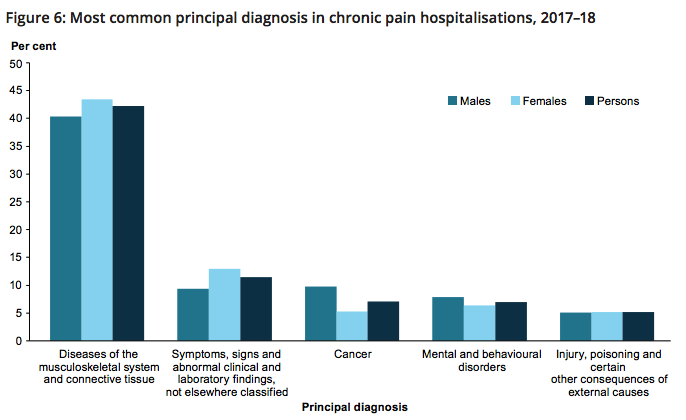Musculoskeletal conditions such as arthritis are the predominant diagnosis in people with chronic pain, according to new data released by the Australian Institute of Health and Welfare (AIHW).
Almost one in five (19%) Australians or an estimated 1.6 million people aged 45 years and over live with persistent, ongoing pain, the Chronic pain in Australia report shows.

Diseases of the musculoskeletal system and connective tissue such as arthritis and back pain were the most common principal pain diagnoses, accounting for 42% of people hospitalised with chronic pain. Other common reasons for hospitalisation were symptoms, signs and abnormal findings (12%), cancer (7.1%), mental and behavioural disorders (7.0%) and injury, poisoning and other external causes (5.1%) (.
In 2017-18 there were nearly 150,000 hospitalisations for chronic pain – most as an additional rather than a principal diagnosis.
Chronic pain patients also spent more time in hospital than other patients (7.5 v 2.6 bed-days).
Data from 2015-16 prior to restrictions on codeine showed that 40% of people with chronic pain were dispensed opioids, other analgesics or migraine medications, and the rate of opioid use was three times higher than people without chronic pain.
The AIHW report said the most common procedures or interventions for chronic pain patients in hospital were allied health such as physiotherapy and occupational therapy (52%), followed by general anaesthesia or sedation (8%) and procedures involved local anaesthetics to a small nerves (6%).
It said the financial cost of chronic pain was at $73.2 billion including $48.3 billion for lost productivity costs and $12.2 billion (17%) for direct health system costs.
“Quality of life reduction costs (including loss of healthy life and premature death) bring the total estimated cost to $139.3 billion. By 2050, it is estimated that the annual cost of chronic pain in Australia will rise to $215.6 billion, partly due to an ageing population,” the report said.
It also noted that people with chronic pain were 2.5 items more likely to have mental health problems compared to people without chronic pain.
Females were almost twice as likely as males to develop chronic pain. Increasing age, socioeconomic disadvantage, a sedentary lifestyle, smoking and high BMI were also known risk factors.